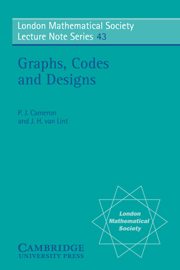Book contents
- Frontmatter
- Contents
- Preface
- 1 A brief introduction to design theory
- 2 Strongly regular graphs
- 3 Quasi-symmetric designs
- 4 Partial geometries
- 5 Strongly regular graphs with no triangles
- 6 Polarities of designs
- 7 Extensions of graphs
- 8 1-factorisations of K6
- 9 Codes
- 10 Cyclic codes
- 11 Threshold decoding
- 12 Finite geometries and codes
- 13 Self-orthogonal codes, designs and projective planes
- 14 Quadratic residue codes
- 15 Symmetry codes over GF(3)
- 16 Nearly perfect binary codes and uniformly packed codes
- 17 Association schemes
- References
- Index
16 - Nearly perfect binary codes and uniformly packed codes
Published online by Cambridge University Press: 16 March 2010
- Frontmatter
- Contents
- Preface
- 1 A brief introduction to design theory
- 2 Strongly regular graphs
- 3 Quasi-symmetric designs
- 4 Partial geometries
- 5 Strongly regular graphs with no triangles
- 6 Polarities of designs
- 7 Extensions of graphs
- 8 1-factorisations of K6
- 9 Codes
- 10 Cyclic codes
- 11 Threshold decoding
- 12 Finite geometries and codes
- 13 Self-orthogonal codes, designs and projective planes
- 14 Quadratic residue codes
- 15 Symmetry codes over GF(3)
- 16 Nearly perfect binary codes and uniformly packed codes
- 17 Association schemes
- References
- Index
Summary
The two 5-designs connected with the Golay codes have very interesting automorphism groups. It is easy to see that the collection of (2e + 1)-subsets of {1, 2,…, n } which support code words of weight 2e + 1 in a binary perfect e-error-correcting code of word length n form an (e + l)-design with parameters (n, 2e + 1, 1), i. e. a Steiner system (cf. [79] (5. 2. 6)). This design can be extended to an (e + 2)- design. These two statements explain the interest of both group- and design-theorists in perfect codes. However, it has been shown that for e > 1 the Golay codes are the only nontrivial perfect codes if the size of the alphabet is a power of a prime (cf. [80], [114]).
We now present some of the theory of binary nearly perfect codes due to J. -M. Goethals and S. L. Snover (cf. [57]). These codes are a special case of the class of uniformly packed codes, introduced by N. V. Semakov, V. A. Zinovjev and G. V. Zaitzef (cf. [106]). These codes also lead to t-designs. Necessary conditions for the existence of such codes are very similar to those for perfect codes. The theory of uniformly packed codes was developed by J. -M. Goethals and H. C. A. van Tilborg. For a survey of most of what is known about these codes we refer to [115], Later in this chapter we shall describe some of the connections between uniformly packed codes, so-called two-weight codes and strongly regular graphs.
- Type
- Chapter
- Information
- Graphs, Codes and Designs , pp. 113 - 123Publisher: Cambridge University PressPrint publication year: 1980



